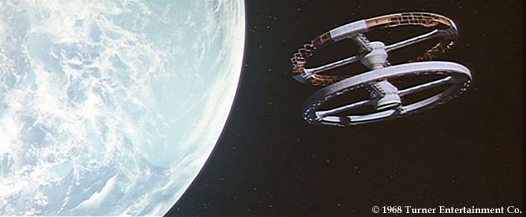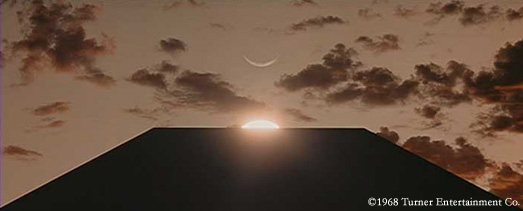|
"A Scientist's Evaluation of 2001" By Walt Lee First published June 2, 1968 |
|||||
|
Stanley Kubrick, with the assistance of Arthur C. Clarke, has produced the most sophisticated science-fiction film ever made. "2001: A Space Odyssey" is the first science-fiction motion picture to reach the level of intelligent speculation that has appeared reasonably often in the better science-fiction magazines since the early 1940s. Its effect, however, is achieved visually, not verbally. Certainly there have been effective science-fiction films before "2001," but they have offered little of the mind-stretching challenge common in written science fiction. The films have mostly been concerned with monsters and gadgets. The reason is quite simple: the science-fiction magazines are edited for a specialized audience of only a few hundred thousand people whereas successful films must appeal to a mass audience at least 10 times as large. Stanley Kubrick and MGM based their $10-million gamble on the belief that the mass audience for films was ready for way-out speculations visually presented. This belief has a strong foundation: The current motion picture audience is composted mostly of young adults under 25. This is the first group in history to grow up with the massive exposure to visual presentations made possible by television. |
|||||
 |
|||||
The fact that "2001" is being received so well (both in terms of approval and emotional understanding) by young audiences testifies to their visual acuity. Differences in evaluating the film seem to result not only from its content but from varying degrees of visual and verbal orientation. (Less than one-third of "2001" has any dialog at all.) In any case, "2001" has become an extremely controversial film and has been widely misunderstood. It is an important picture not only because of the cost and potential box-office return but also because of its unusual content. For all of these reasons, "2001: a Space Odyssey" deserves careful consideration. Kubrick opens his film with the sun rising over an African desert. The location and the conception of the ape-men shown inhabiting the adjoining mountainous region reflect the work of Dr. Louis Leaky. This sequence establishes a key point: the influence of extraterrestrial entities on human evolution. The marvelous African backgrounds were not achieved by shooting on location or by rear projection. Instead, for the first time in a motion picture, the "backgrounds" were projected from the front! In fact, the projection was from exactly the same point of view as the camera. A huge screen of a special reflecting material behind the actors returned the background picture in the same direction from which it came. The actor's shadows on the screen cannon be seen because, from the camera's point of view, the shadows are exactly behind the actors. (This new technique was invented by Will F. Jenkins, who writes science fiction under the name Murray Leinster.) |
|||||
 |
|||||
Once the nature of the ape-men has been established, a black, rectilinear slabs about 12 feet high appears, and is closely examined by the ape-men. After exposure to the slab, one of the ape-men, now a man-ape, discovers the possible use of a bone as a club. He later uses the bone to kill an enemy ape-man from a threatening tribe. The elation felt by the man-ape at his discovery of the club and its successful use is beautifully conveyed. As he joyously throws the bone in the air, we see it rotate in slow motion and turns into a spacecraft. The cut puts man's technological achievements into perspective: tools are just tools, and there isn't much fundamental difference between "primitive" man and technologically advanced man. |
|||||
|
Introduction / Page 2 / 3 / 4 |
|||||
|
Home / Hollywood Stories / Film Sound / Movie Props / Locations Trivia / Events / Tributes / Recommendations / Blog / About Bibliography / Links / FAQs / Shop / Message Board / Disclaimers / Site Map |
|||||
Please support our site by visiting our affiliates: